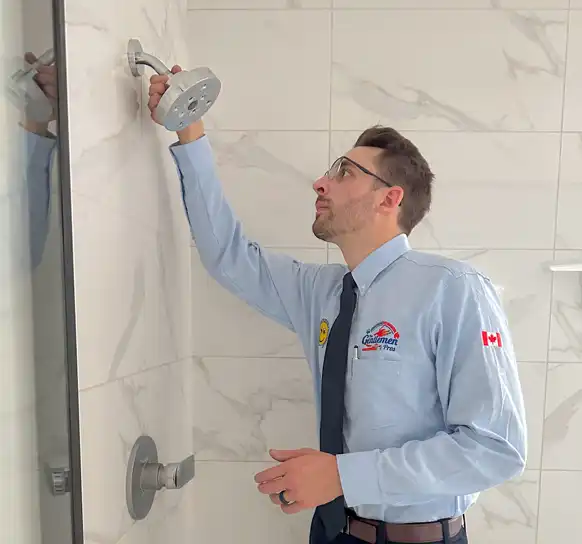We're In Your Neighborhood!

Same Day Service
Since 1992
Call The Gentleman Pros Now!
(403) 754-6648
We're In Your Neighborhood!


Same Day Service
Since 1992
Call The Gentleman Pros Now!
(403) 754-6648

There is never a convenient time for your hot water to conk out, and we know your hot water tank may have an uncanny knack for picking the worst time possible to act up. For instance, you usually discover your hot water woes in the middle of a shower when you are already late for work. My best advice is take a deep breath and keep on reading.
“Stunning service! Richard E was incredibly professional & efficient. He was able to diagnose and repair the issue with our furnace quickly. Same day service and peace of mind for us, knowing our furnace is in good working order. Thank you Gentlemen Pros, you will definitely be our 1st choice if we need your services again.”
Bonnie B

Are your shower or bathtub giving you problems?
Are your faucets or showerhead drip drippin’ away?
Are the pipes so loud you can barely hear yourself think when you are having your shower?
Is the water hanging around for too long in your tub or shower before going down the drain?
These are a few of the ways your shower or bathtub could be giving you headaches.
Red Deer’s The Gentlemen Pros is the medicine you need. We can give you relief by fixing your plumbing problems.
Call (587) 797-2685 and one of our friendly customer representatives will book one of our experienced plumbers for you.
Since the beginning of time, humans have had ways of getting clean. Interestingly, the methods and culture around bathing and showering changed from time period to time period.
Let’s take a walk through the history of bathtubs and showers.
The History of Bathtubs
The history of bathtubs (and showers) is closely tied to the history of indoor plumbing and people’s belief on how healthy or even necessary washing was.
Before indoor plumbing and during periods where indoor plumbing fell out of use, there were portable tubs used for bathing (and probably other things). It would be manually filled with water and when the bathing was done, the water would be emptied and carted away by hand. If you were wealthy, you had servants who did this for you and in some cultures even washed you.
Today it is hard to believe there was ever a time when people believed washing themselves was unhealthy and unnecessary. However, history has shown us that bathing has fallen in and out of fashion.
The earliest evidence of indoor plumbing dates back more than 5,000 years ago to the Indus Valley Civilization. Located in South Asia, this civilization had a water management system and sewage systems that brought water and removed waste from their houses and public buildings.
There is evidence the urban areas of the Indus Valley civilization had public and private baths. However, there is no evidence of individual bathtubs.
The first known bathtub so far to be discovered was found in the Knossos palace on the Isle of Crete. It dates from 1,500 BCE and is a pedestal tub made from hardened pottery and measures five feet long. It was found in what is believed to be the Queen’s bathroom.
The Ancient Greeks and Romans both had indoor plumbing and communal baths. Both cultures believed regular bathing was important for health. Communal bathhouses could be found all through the Roman Empire.
With the collapse of the Roman Empire, their aqueducts, plumbing systems, and infrastructure fell into disrepair. Bathing also fell out of popularity. It was replaced by the use of perfume. A poor substitution.
Bathtubs started to appear as indoor plumbing became more prevalent. Through the 1800s and early 1900, the bathtub was still a freestanding tub usually made from cast iron, copper, or tin. It was manually filled and drained, except for in the homes of the upper classes.
The clawfoot bathtub which was popular in the late 1800s, was first fashioned when feet were added to a horse trough. Its design and materials evolved eventually becoming the beautiful clawfoot bathtub we know today.
Indoor plumbing systems became more common in houses in the post-World War II building boom. This is when the built-in apron front bathtub became more popular.
The discovery of new materials and manufacturing processes impacted how bathtubs were made. In 1883, John Michael Kohler made the first cast iron tub covered in an enamel finish. In 1928, the Crane Company introduced coloured bathroom fixtures to the American market. They gave the homeowner a multiple of coloured tubs to choose from. A pink tub anyone?
In the 1960s, bathtubs started being made out of fibreglass which was lighter and less expensive than previous materials. In 1979, the Wheeler brothers, James and Richard, took the acrylic material used in outdoor spas and adapted the acrylic to make bathtubs.
Today we have a wide selection of materials and features for our bathtubs depending on our tastes and budget.
Waterfalls are the original showers. Early people replicated the effect of the waterfall in their homes by pouring jugs of water over their heads. There is evidence that the wealthy upper classes in Ancient Egypt and Mesopotamia had indoor shower rooms where they had servants bring water in and bathe them.
The ancient Greeks had plumbing that piped water into and removed wastewater from their buildings. Their aqueduct system used gravity to move water from its source to various locations, including large communal shower rooms used by all. Though it was cold showers all around. Hot water was considered suitable only for babies, the elderly, and the sick.
The Romans also had communal shower rooms. They constructed these large bathhouses (which included showers) all across Europe. They believed in showering or bathing at least weekly if not daily. They at least used warm water.
After the fall of the Roman Empire, these bathhouses and aqueduct systems broke down and fell out of use. As did regular bathing and showering.
In 1767, in England, William Feetham was issued a patent for a mechanical shower. It used a hand pump to move water into a tank above the user’s head. The user would then pull a chain to release the water, “showering” it down on them. This shower didn’t catch on for a couple of reasons, one being that this shower reused the same water over and over again.
In the early 1800s, the English Regency Shower was invented by an unknown person. It was in a metal frame which was painted to look like bamboo which was popular during this era. It was the first hot water shower but like Feetham’s shower it reused the same water over and over again.
This design was steadily improved upon in the decades after, until it was similar to our showers today.
Showers started to become more common in the homes of the wealthy when the advent of indoor plumbing allowed showers to be hooked up to running water.
Fast forward to today and there are plenty of choices when it comes to installing a shower.



